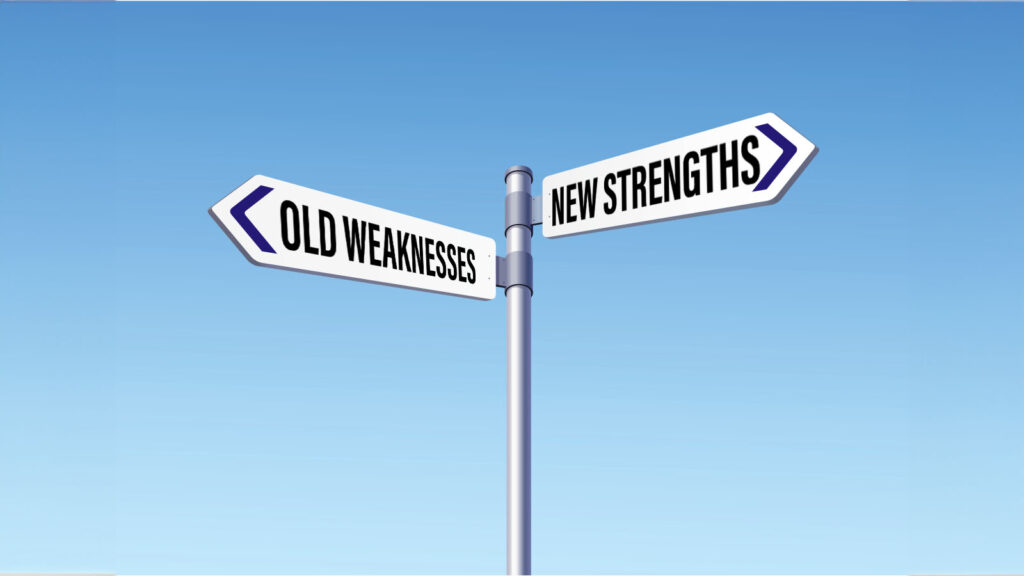I would like to argue against the theory that leaders benefit when they only utilize their strengths and surround themselves with people who have different strengths. Here are examples of that theory: “Employees are happiest when they can utilize their strengths every day at work.” Authors Tom Rath and Barry Conchie argue, “If you spend your life trying to be good at everything, you will never be great at anything.” (Strengths Based Leadership). Peter Drucker wrote in, The Effective Executive: “The Effective executive builds on strengths – their own strengths, the strengths of superiors, colleagues, subordinates; and on the strengths of the situation.” Marcus Buckingham has written many books about putting our strengths to work. In his book, Go Put Your Strengths to Work, he lays out convincing evidence for “…getting each person to play to his strengths.”
There are benefits to strengths-based approach. But I propose that there are also weaknesses. Many of the challenges I see in organizations and relationships come from the overuse of strengths and the lack of awareness of the impact of our weaknesses. I agree with psychologist Martin Seligman, that happiness and success does not come from studying our failures, disorders, or the negative aspects of life. He suggests that living a meaningful and fulfilling life comes when we overcome challenges, redefine attitudes and work on activities that are meaningful and energizing for us. I believe happiness and success comes from utilizing our strengths combined with a strategic focus on our weaknesses, blind spots, and blocks to leadership and communication. This means overcoming challenges and redefining attitudes. Managing your strengths and weaknesses well will have a positive impact, which will be meaningful and energizing for us.
I recently heard a speaker at a global conference say that if you just focus on your strengths, it will “pull up” or strengthen your weaknesses. I disagree. Working on your strengths may hide your weaknesses. Let me give you a couple of sports analogies. A golfer must use many different clubs to be successful at the game of golf. The golfer may excel at one or more of the clubs and struggle with others. Let’s say a golfer is brilliant with the driver but struggles with the putter, will just focusing on getting better with the driver, (strength) improve their putting game (weakness)? No, the golfer will have to focus on improving putting if they want to play championship golf.
Figure skating champion and Olympic gold medalist. Scott Hamilton was continually at the bottom of junior national’s 9th, 9th, 7th, until after dedicating his season to his mother who was diagnosed with cancer. He showed up with intention and commitment and he won. When he was 18, he went on to compete in senior nationals and came in 9th in the U.S. This was the last time his mother ever saw him skate. The next year he “took his mother with him” every day on the ice. He decided to be the best skater he could possibly be and increased his commitment. This changed everything. He came in 3rd in the U.S. and 11th in the world. Two years later he made the Olympic team. In the 1980 Olympics, he came in 5th. Robin Cousins was the gold medalist, Jan Hoffman was the silver medalist, Charlie Tickner won bronze. Hoffman went to medical school and Cousins and Tickner went pro the next year. He woke up one day and was ranked 2nd in the world!
He asked himself what he had to do to pass the number one ranked skater? The world’s best figure skater was brilliant in the compulsory figures which were Scott’s weakness. Scott said, “I hated figures, and they hated me back.” To close the gap with this excellent skater, he decided he had to “fall in love with compulsory figures.” This was the part of the job he hated. He decided to change his attitude. Scott asks his kids today. “What is the greatest strength? Lack of weakness. Figure out where you are weak and get strong!” He suggests if you keep working on those weaknesses the stronger you are going to get in all areas. You are adding your weaknesses to the strength’s column. This seems to contradict the strengths-based approach. Scott came to love figures and because of this from 1981-84 he never lost a championship.
Another example of working on weaknesses comes from the basketball player Shaquille O’Neil. Arguably one of the most dominant centers to play the game. He won four championships in his 19 years of playing in the NBA. However, Shaquille had a weakness…free throws. He was so strong in all other aspects of his game he could almost get away with not working on his free throw skills. He was so poor at free-throws it was hard to watch. He was the 5th worst in NBA history, Teams began to strategically exploit this weakness. At the end of games, opposing teams learned all they had to do to stop Shaquille and his team was to foul him and he would miss over 58% of free-throws his worst year. This fouling practice became so prevalent it was given a name, Hack a Shaq! He worked on this weakness and improved his career regular season free-throw percentage to 52.7%. In 2009-10 he played in 11 playoff games and his FT% was 66%!
Working on weaknesses can help us to become more resilient! Have you ever heard the saying, “Do what you love, and you never have to work a day in your life.”? I believe this mindset sets you up for failure. I love what I do. I have the privilege of speaking to audiences all over the world. I coach leaders and help working teams perform at a higher level. People thank me for helping them in their lives. What is not to love about this? There are parts of my work that are tedious and frustrating. These parts are work – the feel like work.
I work with some leaders that are not self-aware and this takes patience. Patience is a weakness of mine. I get to constantly work on my craft. I am regularly asking for feedback on my speeches and workshops. This is not always comfortable. In fact, I would say that receiving feedback was not always my strength. This hindered me from getting better. I have learned to like and seek feedback more, as a result I am improving faster and achieving better results. As I turn this weaknesses to strengths, my other strengths have more power.
Research by the Hay/McBer consulting firm of 3,871 executives worldwide found that the best leaders are skilled at six styles of leadership: Coercive, Authoritative, Pacesetting, Affiliative, Democratic, and Coaching. They have the flexibility to switch styles as the circumstance dictates. Remember our golf example. The best golfers can use the best club for the circumstance. I have found in working with hundreds of leaders worldwide, most leaders excel at two or three of these styles and struggle with two or three. For example, a leader who has strengths with the coercive, authoritative, and pacesetting styles is usually weak with the democratic, affiliative, and coaching styles and vice versa. If someone is great at being coercive, working on strengthening their ability to be coercive or more authoritative will have disastrous effects. Learning how to be more affiliative, and coaching will have immediate positive benefits. Likewise, a leader who is strong at the democratic and affiliative styles will benefit from being able to be more authoritative and even coercive in small doses when the need arises.
How do you work on your weaknesses without draining your motivation and energy?
1. Identify your strengths and weaknesses. Use a great assessment with the help of an expert who can help you review your results for accuracy. Here is a link to one of the most credible and effect assessments available.
2. Understand that you don’t have to be an expert at your weaknesses. Just improving a little in those areas will have a big net positive impact. Just getting 3-5% better at your weaknesses will have an exponential positive impact. Strive for incremental improvement, not perfection. If you rate yourself a 3 on a scale of 1-10 on one weakness, work on getting to 4, not 10.
3. Prepare mentally and physically to work on weaknesses. This will take energy just like learning something new or getting out of your comfort zone. Minimize energy drain by working on one, and no more than two weaknesses at a time.
4. Give yourself grace when you fail or struggle. Instead of judging yourself, get curious about what happened when you struggled with the new behavior. What were the circumstances? What can I do differently next time?
5. Celebrate when you have a win. Reward yourself for small wins. This will help you desire to keep striving. Plan to do something that energizes you after your “mental workout.” This could include a nap!
Only relying on your strengths and ignoring your weaknesses will not produce the results you desire as a leader, or in your most important relationships. Think of the achievements you are most proud of. I imagine they are the ones that were the most difficult to achieve. Working on our strengths will not provide the same dopamine rush as overcoming an obstacle or winning when you are the underdog. Remember that it will take energy and commitment. Keep using your strengths. Using your strengths in meaningful ways will bring happiness and meaning. But you will find strength overcoming the weaknesses which are holding you back from deeper personal connection, greater team engagement, a championship, or even an Olympic gold medal!
The Author Spencer Horn is the President of Altium Leadership For additional information consider the following topics: “People Not Performing? Look in the Mirror”, “The One Skill Executives Struggle With the Most”, “The Power of Accountability;”, “Love What You Do”, “The Truth About Authentic Leadership”, “How To Solve More Problems As A Leader”, “How to Prepare Your Next Generation of Leaders”, “Why Employees Don’t Do What You Hired Them To Do” “Enhance Your Leadership Style”

